

 Share This Page
Share This Page| Home | | Sailing | | Alaska 2007 | |  |  |  Share This Page Share This Page |

Copyright © 2007, P. Lutus. All rights reserved. Message Page
(double-click any word to see its definition)
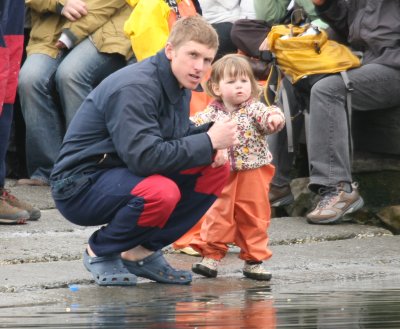
Kodiak is not your average American town. It sits on the east side of Kodiak Island, exposed to much of the region's famously bad weather, and the people spend a lot of time on boats, fishing. These are not pleasure boaters and their boats are not pleasure craft. Some of these boats have seen better years, some have seen better decades. If the professional fishermen are lucky, both they and their boats will end up on a beach in dry, boring retirement. If they are not so lucky, their boat will sink and they will be thrown into the water. This outcome is all too common.
The fishermen (and women) have a strategy for dealing with sinking boats — they deploy a liferaft and make their way from the sinking boat to the liferaft. Sound simple? Think again. By the time the liferaft is deployed, inflated and ready for use, it might be blown 100 yards or more from the sinking boat, and the crewmembers must swim from the boat to the raft. To add to the pickle, the water might be 38° Fahrenheit (3° Celsius) on a good day, or below freezing, as well as windy, on an average day. (The reader may wonder how the water temperature can be below freezing, without actually freezing. Well, it's salt water, which doesn't freeze at 32° Fahrenheit, but a lower temperature.)
Consider this. How does a person swim 100 yards through windy, freezing water, from a sinking boat to a liferaft? Won't he die of hypothermia on the way? Well, strictly speaking, yes, he will, unless he first puts on a survival suit. Each crewmember has a survival suit on board, stowed in a big orange bag, and if the boat should begin to take on water, he must don the suit before leaving the boat. If a person should get hasty and jump overboard without the suit, he might die immediately on hitting the cold water (yes, this happens).
Isn't this all very hypothetical? Isn't it overcautious, like wearing a crash helmet while driving a car? No, not at all — commercial fishing is the most dangerous job there is. It's more dangerous than being a policeman, or a fireman, or anything else you can name. And if the boat should go down, the most critical phase is getting safely from the boat to the liferaft.
Each year around Memorial Day, the City of Kodiak has a public competition, a survival suit race, and the entire town turns out for this popular event. Each contestant must successfully:
Typically the contestants organize into teams, who do all they can to help each other out (just like crewmembers on a fishing boat). And this contest is quite realistic, right down to the water temperature, which is typically a lethal 38° Fahrenheit on the day of the contest.
Here is a photo gallery of this year's race:
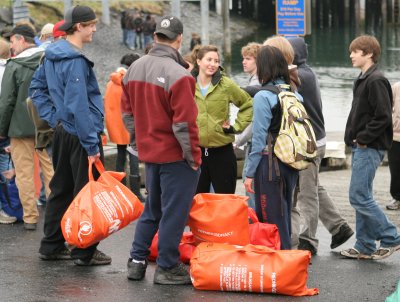
Waiting for the competition
|

Running to the water's edge
|

This race isn't just for boys
|
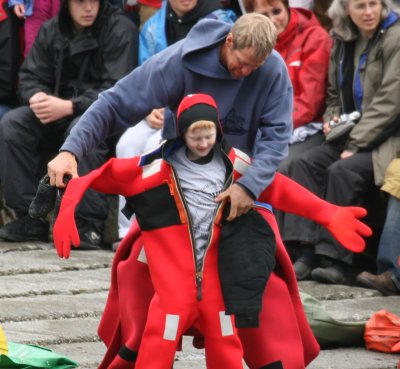
Dad helps his son (there aren't any small survival suits)
|
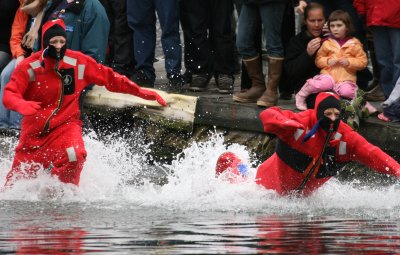
Even in a suit, entering the water can be daunting
|
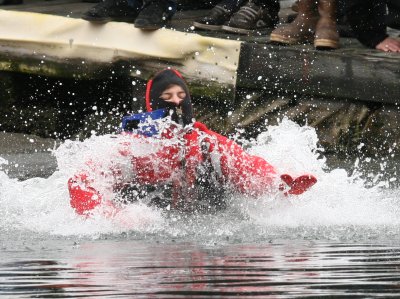
It's just as cold as it looks
|
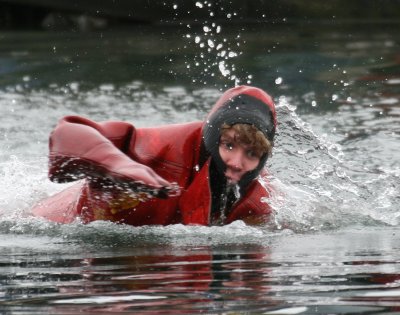
Swimming to the raft in the suit is somewhat like swimming in a potato sack
|
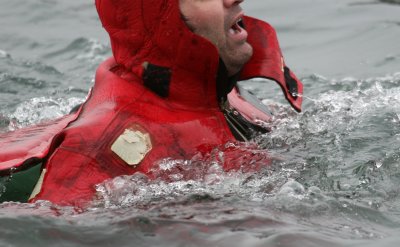
Sometimes a rehearsal becomes the real thing — this man's suit popped open and quickly flooded with cold water. This can be dangerous and time is short. He was quickly rescued.
|

Team members help each other aboard the raft
|
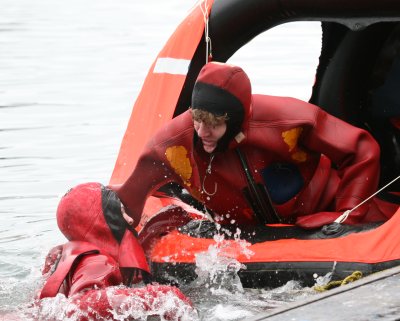
Up and out!
|
Hypothermia
"Hypothermia" is the name for a condition in which one's body temperature is forced below a safe limit (usually 95° Fahrenheit or 35° Celsius). In cold water, hypothermia can take hold with dangerous speed. In Alaskan waters, a person may only have 15 or 20 minutes to get out of cold water before losing consciousness and life.
The danger isn't ended by taking a person out of the water. Raising a hypothermia victim's body temperature back to normal is a tricky business, and many things can go wrong at this phase of a rescue. It turns out that common sense is of little use in rescuing a person from the aftereffects of cold immersion. There is a case where 16 Norwegian fishermen were rescued from the North Sea, but after a short time on the rescue boat, all of them died, possibly by having been warmed up too quickly either through exercise or hot drinks.
A little more detail. While immersed in cold water, our blood vessels constrict to decrease the rate at which heat energy is lost. Once a person is removed from the water, the constricted vessels continue to prevent the cold blood in the extremities from flowing into the torso. If the cold blood is allowed to flow too freely, one's core temperature may drop dangerously low — a condition called "core temperature afterdrop."
In short, there are many cases in which common sense and compassion on the part of inexperienced rescuers have caused an unnecessary death. In my opinion, the best thing to do is become familiar in advance with accepted first aid procedures, and in a real rescue situation, contact rescuers who have hypothermia training.
Further reading: Hypothermia: First aid (Mayo Clinic)
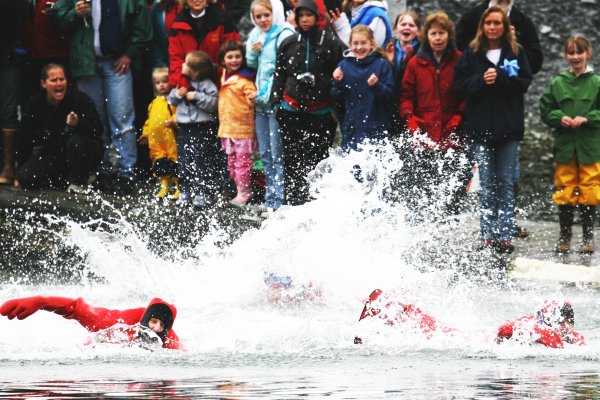
A uniquely Alaskan contest
|
| Home | | Sailing | | Alaska 2007 | |  |  |  Share This Page Share This Page |